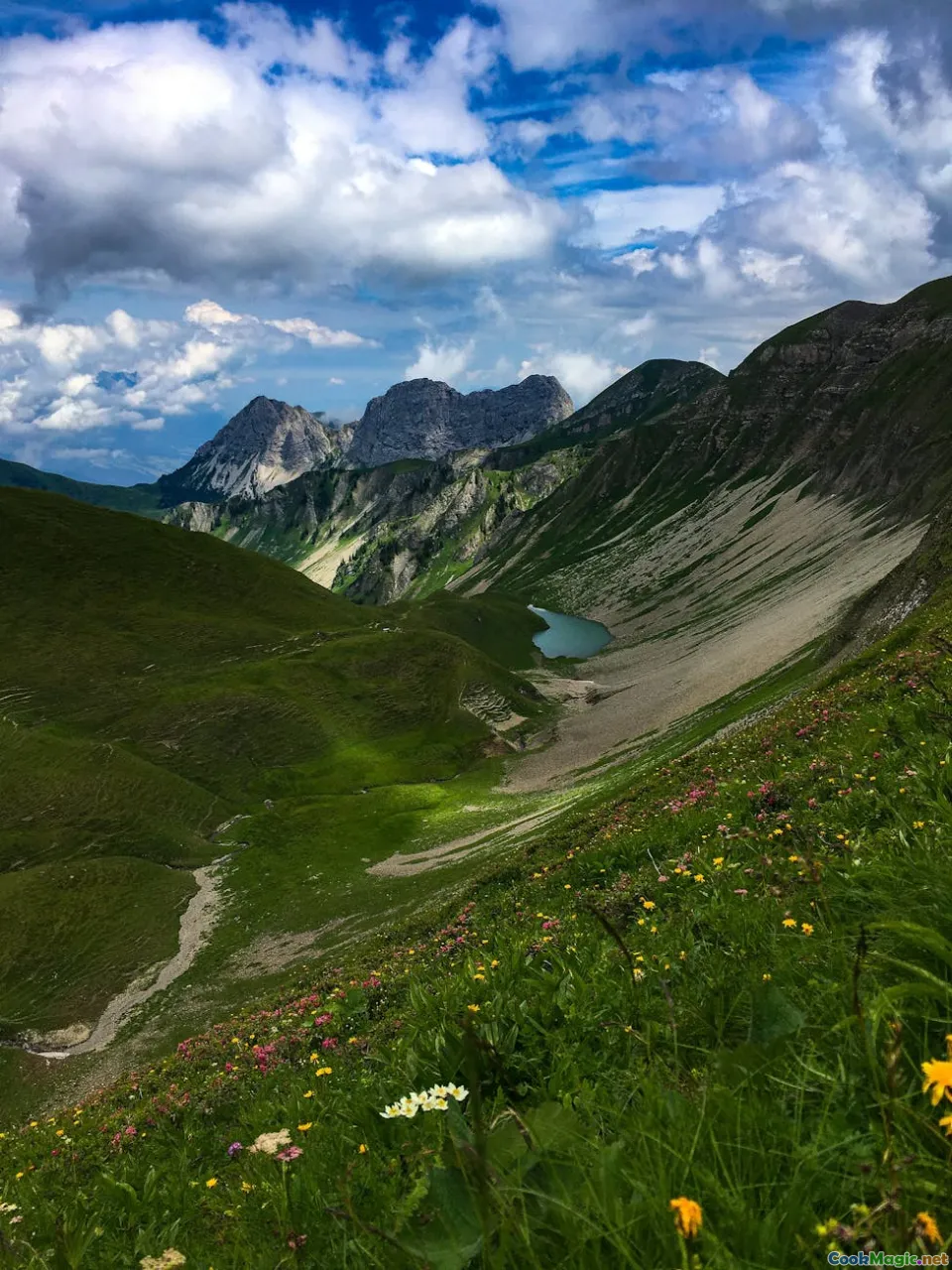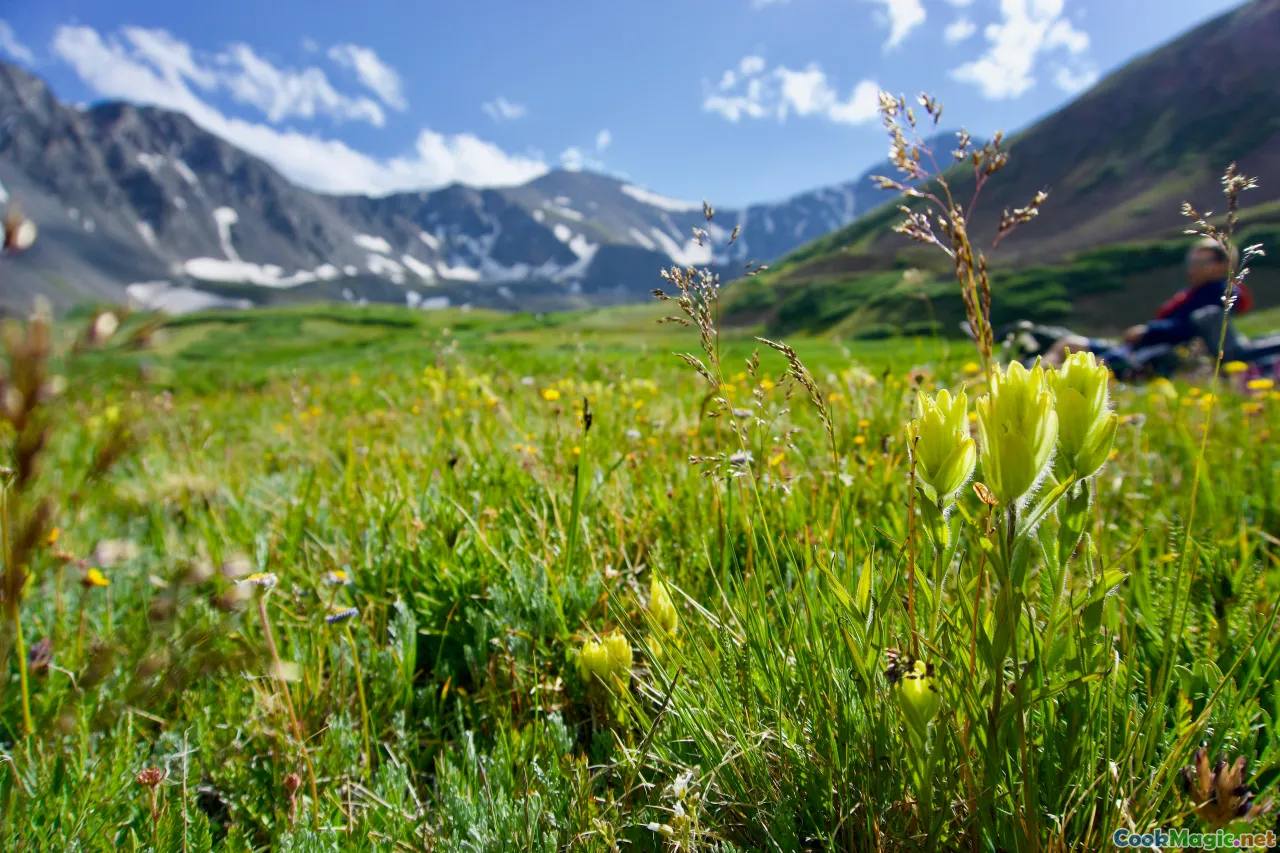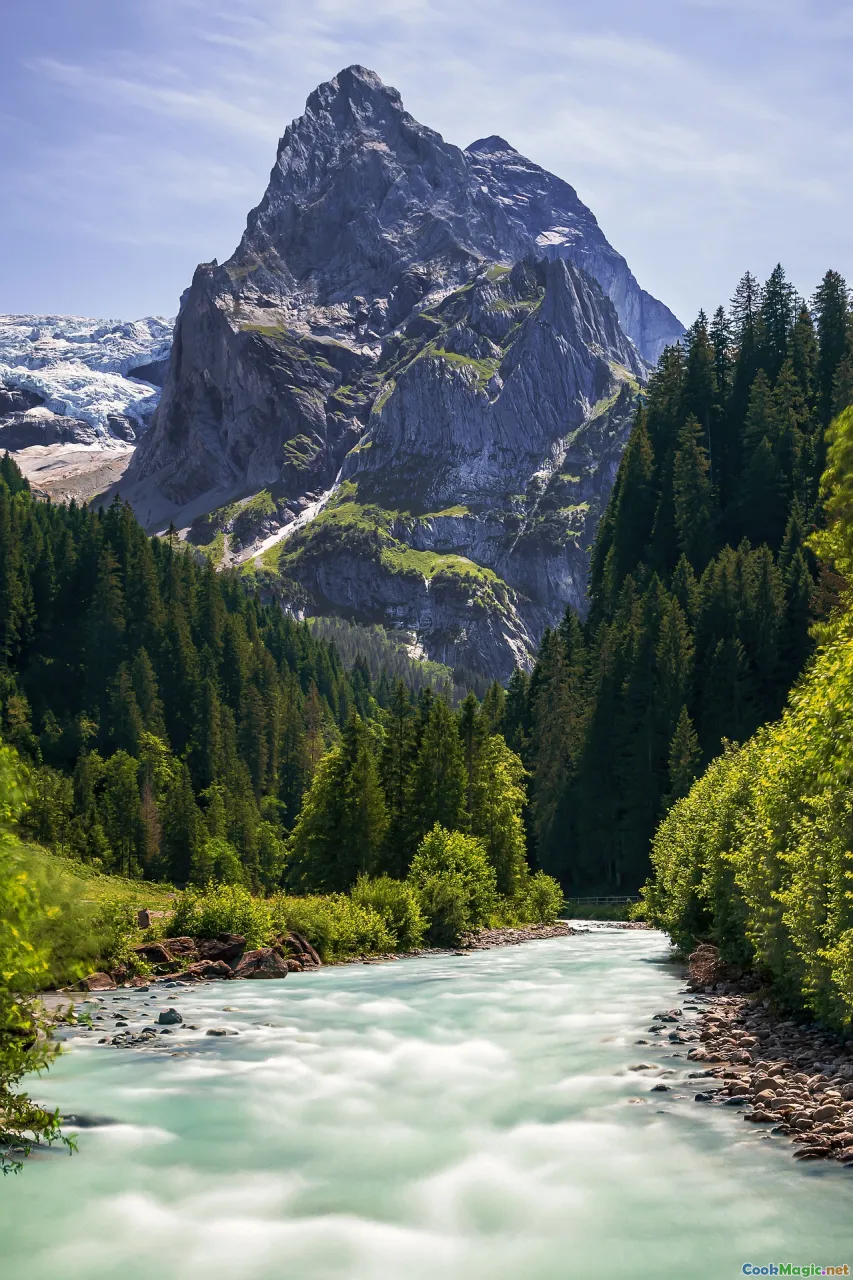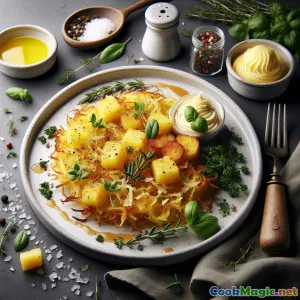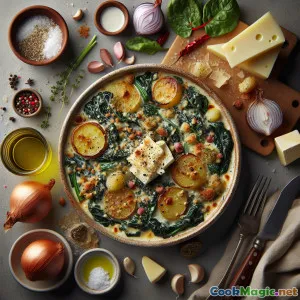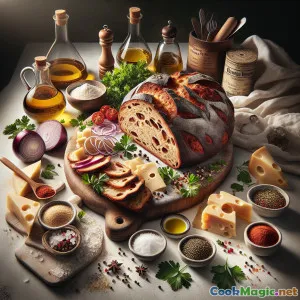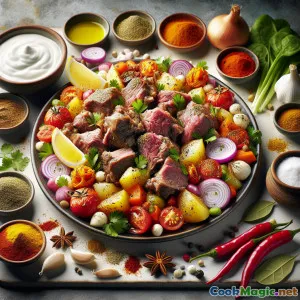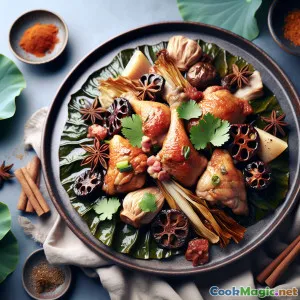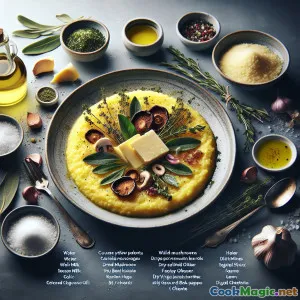
Polenta aus Tessin mit Bergkräutern
(Ticino Polenta with Mountain Herbs)
(0 Bewertungen)0
42
November 11, 2025
Problem melden
Zutaten
-
280 grams Grobe gelbe Polenta (Bramata-Maismehl)
(Coarse grind yields the best rustic texture)
-
900 ml Wasser
(Plus more as needed for final adjustment)
-
350 ml Vollmilch
(Swap with vegetable stock for dairy-free)
-
20 grams Getrocknete Steinpilze
(Quick rinse removes grit before soaking)
-
250 ml Warmes Wasser zum Einweichen getrockneter Steinpilze
(Strain and use the flavorful liquid)
-
40 grams Ungesalzene Butter
(Use olive oil for a vegan version)
-
2 tbsp Natives Olivenöl extra
(Good-quality oil enhances herb aroma)
-
120 grams Alpenkäse (Sbrinz oder gereifter Gruyère), fein gerieben
(Pecorino can substitute; adjust salt accordingly)
-
2 tbsp Bergkräuter-Mischung (Salbei, Thymian, Bohnenkraut), fein gehackt
(Rosemary or oregano work if wild herbs are unavailable)
-
2 cloves Knoblauch (gehackt)
(Frisch gehackt für den besten Geschmack)
-
1 tsp Zitronenschale, fein gerieben
(Brightens the rich flavors)
-
60 ml trockener Weißwein
(Deglazes the pan; omit for alcohol-free)
-
1 leaf Lorbeerblatt
(Infuses the cooking liquid)
-
1.5 tsp feines Meersalz
(Season gradually; cheese adds salt too)
-
1 tsp Frisch gemahlener schwarzer Pfeffer
(Mehr nach Geschmack hinzufügen)
-
80 grams Geröstete Kastanien, zerbröselt
(Rustic garnish that echoes Alpine flavors)
-
60 grams Speck oder Pancetta, gewürfelt
(Crisped topping for non-vegetarians)
-
2 tbsp Frischer Schnittlauch, fein geschnitten
(Fresh finish)
-
150 ml Zusätzliches heißes Wasser oder Milch, nach Bedarf
(Adjusts final consistency just before serving)
(Coarse grind yields the best rustic texture)
(Plus more as needed for final adjustment)
(Swap with vegetable stock for dairy-free)
(Quick rinse removes grit before soaking)
(Strain and use the flavorful liquid)
(Use olive oil for a vegan version)
(Good-quality oil enhances herb aroma)
(Pecorino can substitute; adjust salt accordingly)
(Rosemary or oregano work if wild herbs are unavailable)
(Frisch gehackt für den besten Geschmack)
(Brightens the rich flavors)
(Deglazes the pan; omit for alcohol-free)
(Infuses the cooking liquid)
(Season gradually; cheese adds salt too)
(Mehr nach Geschmack hinzufügen)
(Rustic garnish that echoes Alpine flavors)
(Crisped topping for non-vegetarians)
(Fresh finish)
(Adjusts final consistency just before serving)
Nährwerte
- Portionen: 4
- Portionsgröße: 1 Schüssel (300g)
- Calories: 620 kcal
- Carbohydrates: 0 g
- Protein: 22 g
- Fat: 28 g
- Fiber: 5 g
- Sugar: 7 g
- Sodium: 720 mg
- Cholesterol: 60 mg
- Calcium: 380 mg
- Iron: 2.8 mg
Anweisungen
-
1 - Prep and Soak:
Rinse porcini quickly, then soak in 250 ml warm water for 20 minutes. Strain through a fine sieve or coffee filter, reserving the liquid. Chop the rehydrated mushrooms. Chop herbs, mince garlic, and grate the cheese.
-
2 - Heat the Base:
In a heavy pot, combine water, reserved porcini soaking liquid, milk, and the bay leaf. Bring to a gentle simmer over medium heat; remove bay leaf before adding polenta.
-
3 - Toast the Polenta:
In a dry skillet, lightly toast the polenta over medium heat for 2–3 minutes until nutty. This optional step deepens flavor and reduces clumping.
-
4 - Whisk In Slowly:
While the liquid simmers, rain in the polenta gradually, whisking constantly to prevent lumps. Reduce heat to low once incorporated.
-
5 - Low and Slow Cooking:
Stir frequently with a wooden spoon, scraping the bottom. Maintain gentle bubbles. Cook 35–45 minutes until grains are tender and the polenta is creamy. Add small splashes of hot water if it thickens too quickly.
-
6 - Herb–Porcini Butter:
In a skillet, warm butter and olive oil over medium heat. Add garlic; sizzle 30 seconds. Stir in chopped porcini and half the herbs; cook 2 minutes. Deglaze with white wine (if using), reduce to syrupy, then add lemon zest.
-
7 - Enrich and Season:
Remove polenta from heat. Stir in half the herb–porcini butter and all the grated cheese. Season with salt and black pepper. Taste and adjust.
-
8 - Optional Toppings:
Crisp speck or pancetta in a small pan. Warm the crumbled chestnuts in the same pan to toast edges. Keep chives ready for finishing.
-
9 - Rest and Adjust:
Let polenta rest 3–5 minutes; loosen with additional hot water or milk to reach a slow-ladling consistency. Final whisk for silkiness.
-
10 - Serve:
Spoon polenta into warm bowls. Swirl over remaining herb–porcini butter, scatter chestnuts and chives, and add crisp speck if using. Finish with a twist of pepper and serve immediately.
Rinse porcini quickly, then soak in 250 ml warm water for 20 minutes. Strain through a fine sieve or coffee filter, reserving the liquid. Chop the rehydrated mushrooms. Chop herbs, mince garlic, and grate the cheese.
In a heavy pot, combine water, reserved porcini soaking liquid, milk, and the bay leaf. Bring to a gentle simmer over medium heat; remove bay leaf before adding polenta.
In a dry skillet, lightly toast the polenta over medium heat for 2–3 minutes until nutty. This optional step deepens flavor and reduces clumping.
While the liquid simmers, rain in the polenta gradually, whisking constantly to prevent lumps. Reduce heat to low once incorporated.
Stir frequently with a wooden spoon, scraping the bottom. Maintain gentle bubbles. Cook 35–45 minutes until grains are tender and the polenta is creamy. Add small splashes of hot water if it thickens too quickly.
In a skillet, warm butter and olive oil over medium heat. Add garlic; sizzle 30 seconds. Stir in chopped porcini and half the herbs; cook 2 minutes. Deglaze with white wine (if using), reduce to syrupy, then add lemon zest.
Remove polenta from heat. Stir in half the herb–porcini butter and all the grated cheese. Season with salt and black pepper. Taste and adjust.
Crisp speck or pancetta in a small pan. Warm the crumbled chestnuts in the same pan to toast edges. Keep chives ready for finishing.
Let polenta rest 3–5 minutes; loosen with additional hot water or milk to reach a slow-ladling consistency. Final whisk for silkiness.
Spoon polenta into warm bowls. Swirl over remaining herb–porcini butter, scatter chestnuts and chives, and add crisp speck if using. Finish with a twist of pepper and serve immediately.
Mehr über: Polenta aus Tessin mit Bergkräutern
Ticino Polenta with Mountain Herbs
Ticino, the Italian-speaking canton of Switzerland, lives at the crossroads of Alpine heartiness and Mediterranean brightness. This recipe pays homage to both sides: slow-stirred, bramata-style polenta finished with mountain herbs, porcini, and a generous handful of aged Alpine cheese. The result is a bowl of deep comfort—silky, aromatic, and layered with savory depth—perfect after a brisk hillside walk or a winter evening by the fire.
About the dish
Polenta has long been a staple across northern Italy and southern Switzerland, where maize found a home centuries ago. In Ticino, polenta is traditionally cooked in a paiolo, a copper cauldron, over a wood fire. The technique is patient and unhurried; grains open and release starch, transforming into a creamy, spoonable canvas for whatever the mountains offer—herbs, mushrooms, cheese, and sometimes cured meats.
This version channels the forest floor with dried porcini, whose soaking liquor becomes a natural stock. A lemon-kissed herb butter—sage, thyme, and savory—cuts through the richness, while a final shower of Sbrinz or aged Gruyère ties everything together with a nutty, crystalline bite. Optional toppings, like toasted chestnuts and crisped speck, bring texture and an echo of autumn markets.
Ingredient spotlight
- Coarse polenta (bramata): Coarser grains stay pleasantly rustic, never gluey, and deliver satisfying bite.
- Dried porcini: A pantry treasure. Their soaking liquid is liquid umami—don’t discard it.
- Alpine cheese: Sbrinz offers crystalline crunch and depth; Gruyère brings nutty sweetness. Pecorino works if you prefer a saltier edge.
- Mountain herbs: Sage, thyme, and savory are classic. Rosemary or a touch of wild oregano are fine substitutes.
- Lemon zest: A small detail that brightens the entire bowl, preventing flavors from feeling heavy.
Technique notes
- Stirring rhythm: Early whisking prevents lumps. Once thickened, switch to a wooden spoon and stir every few minutes, scraping the bottom and sides. The goal is gentle, steady heat with soft bubbling.
- Liquid balance: Polenta is forgiving. If it seizes or becomes too thick, add a splash of hot water or milk and whisk vigorously. If too loose, cook a bit longer, stirring, to evaporate excess moisture.
- Herb butter timing: Dividing the herb–porcini mixture gives flavor in layers—first folded into the polenta for depth, then spooned over the top for aroma and sheen.
Tips and swaps
- Make it vegan: Use olive oil instead of butter, plant-based milk or vegetable stock, and a vegan hard cheese alternative or nutritional yeast.
- Alcohol-free: Skip the wine; add a teaspoon of cider vinegar or a squeeze of lemon to the herb pan for brightness.
- Hands-off method: After whisking polenta into the simmering liquid, cover and bake at 160°C for 45–60 minutes, stirring every 15 minutes. Finish on the stovetop with cheese and herb butter.
- Texture preferences: For extra creamy polenta, add a small knob of butter and splash of milk just before serving and whisk vigorously.
- Herb flexibility: In summer, add a few chopped wild greens or nettles (blanched) for a fresh, green twist.
Serving ideas
- As a main: Top with chestnuts, remaining herb butter, and chives. Add a crisp salad of bitter leaves with a lemony dressing to contrast the richness.
- With mushrooms: Pile sautéed chanterelles or cremini on top for a fully vegetarian feast.
- With meat: Crisped speck or pancetta is traditional in many mountain homes; a few shards go a long way.
History and cultural context
Maize arrived in the Alpine regions in the 16th century, gradually replacing chestnut flour porridges. In Ticino, polenta became both everyday sustenance and a celebratory dish, often cooked outdoors in a hanging paiolo while families gathered. The combination of mushrooms, herbs, and cheese is anchored in seasonal rhythms—porcini drying racks in autumn, herb bundles hanging from rafters, and wheels of cheese aging quietly through winter. This recipe borrows these rhythms, offering a taste of storied valleys, alpine pastures, and the markets that bridge Swiss and Italian culinary traditions.
Make-ahead and storage
- Cool leftover polenta in a shallow pan until set. Slice and pan-fry the next day in a little butter or oil until crisp and golden on both sides—perfect with a fried egg or a handful of sautéed greens.
- Store in an airtight container up to 3 days. To reheat creamy polenta, stir with hot water or milk on the stovetop until smooth again.
Chef’s thoughts
What makes this plate sing is the interplay of textures: the creamy base, the chew of porcini, the slight crunch of good Alpine cheese, and the soft crumble of chestnuts. The lemon zest, though subtle, is indispensable; it lifts the herbs and brightens the earthy backbone. Don’t rush the cooking—polenta rewards patience. A low flame, a wooden spoon, and a few attentive stirs will reward you with a bowl that tastes like mountain air and warm kitchens.

